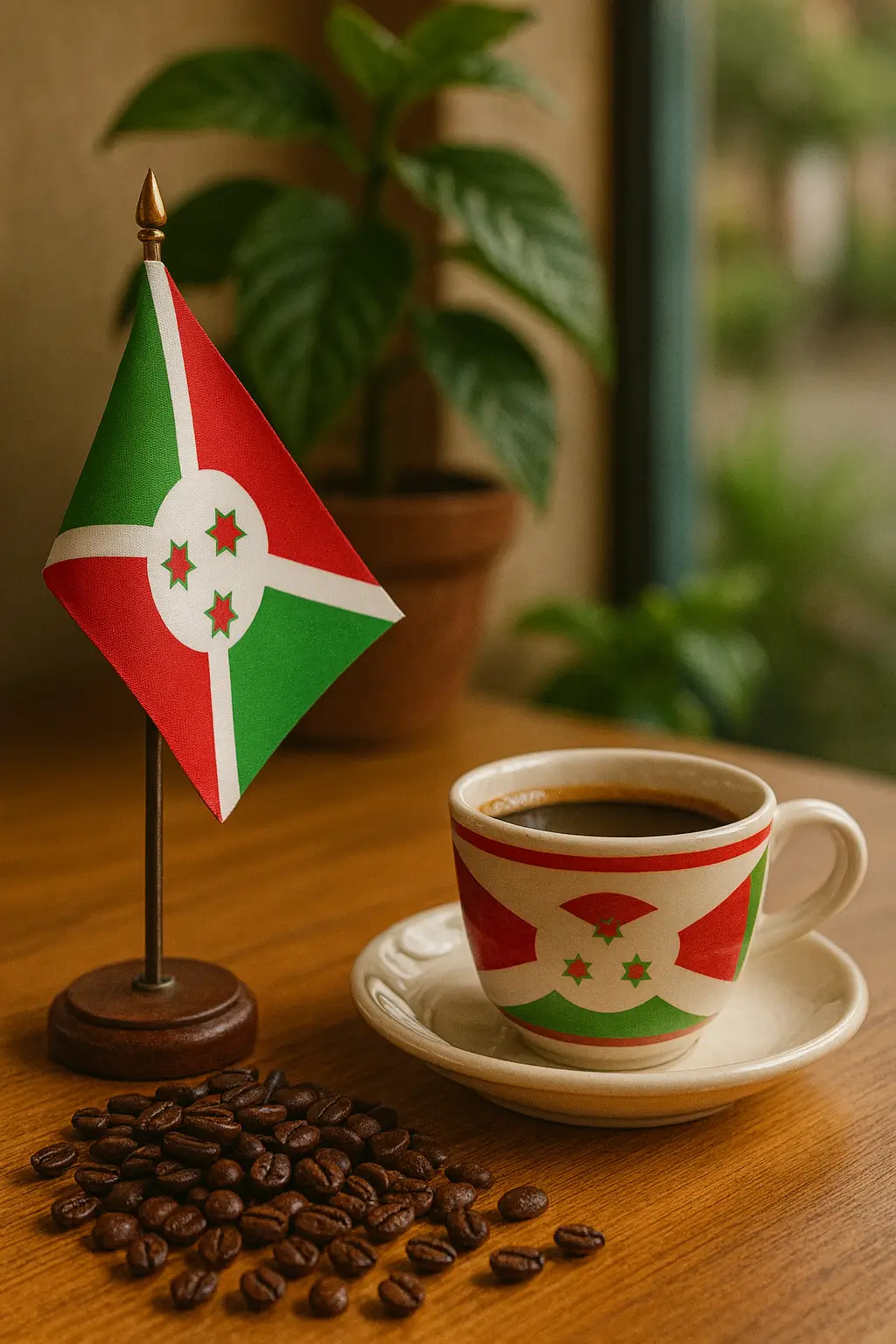Burundi coffee is a specialty Arabica from East Africa. Many people want it. It has a distinct taste. Burundi works hard to produce quality coffee, even after facing tough times. The Specialty Coffee Association (SCA) gives it high scores. This shows its high quality. Let’s explore what makes Burundi coffee special. We’ll look at its unique taste and how it goes from the farm to your cup.
The unique flavor of Burundi coffee
Burundi coffee has a lively taste. It grabs coffee lovers. You’ll find bright acidity, like citrus. Think orange, lemon, or grapefruit. Its taste reminds many of fine black tea, not chocolate. This gives it a refined feel.
Expect sweet fruit notes. You might taste red berries, stone fruits, or tropical fruits. Blueberry hints often appear. Sometimes, it has cooked berries or black currant. Delicate flowers, like jasmine or orange blossom, join the fruit. You might also find herbal or hibiscus hints. The coffee feels rich and silky in your mouth. It leaves a clean, sweet taste that stays a while.
You’ll also find sugar-browning flavors. Think caramel, brown sugar, and honey. These notes add depth. They give a pleasing sweetness. The washed processing method creates this complex taste and smell. This method brings out clarity and brightness. Careful fermentation and drying also play a role.
This mix of bright acidity, sweet fruit, and floral notes makes Burundi coffee complex. It’s a rewarding taste. Knowing these traits helps you enjoy each sip of this East African coffee.
Where Burundi coffee grows
Burundi coffee grows mostly in the north and center. Specific geography and climate create a perfect spot. Top growing regions include: Kayanza, Ngozi, Buyenzi, Mumirwa, Bweru, Bugesera. These spots are high up, from 1,200 to over 2,000 meters above sea level.
Kayanza and Ngozi provinces have high peaks. Some farms sit at 2,050 meters. These heights mean cooler weather. Cherries ripen slowly. This slow growth helps beans build complex sugars and acids. It makes Arabica coffee flavors stronger.
These areas get steady rain. This helps coffee plants grow strong. Mumirwa, for example, gets about 1,100 mm of rain each year. This ensures enough water. Volcanic soil is also rich in nutrients. Places like Bweru and Ngozi have this soil. It feeds the plants and directly affects bean quality.
Burundi is in the Great Lakes region. This means stable temperatures all year. It creates a good microclimate for coffee. Rivers like the Ruvubu and Kanyaru provide water. They help with irrigation and processing. High elevation, steady rain, rich soil, and stable temperatures. This mix makes Burundi’s coffee regions perfect for growing great specialty Arabica.
How Burundi coffee is processed
How coffee is processed in Burundi changes its final taste. Washed processing is most common. This method removes the outer layers and sticky mucilage from the cherry. Then, they dry the beans. Washed processing usually involves:
- Fermentation for 10–12 hours,
- Thorough washing,
- Density grading.
This creates coffee known for its clarity, brightness, and strong acidity.
Washed processing is king, but some use natural (dry) processing. It’s less common for Burundi. Natural processing dries the whole coffee cherry, fruit and all. This gives stronger fruit flavors and a heavier body. These natural coffees are often very sweet. They have a complex, jammy taste.
Honey processing is also growing in Burundi. This is a hybrid method. They remove the skin, but leave some sticky mucilage on the bean. Then they dry it. Honey-processed coffees balance sweetness and body from natural coffees. They also get crisp acidity and clarity from washed coffees. This creates complex cups. Each method adds unique traits to Burundi coffee. This gives it a wide range of flavors.
Key varietals of Burundi coffee
Burundi grows mostly Bourbon coffee. This includes its subvarieties. It’s a strong part of the country’s coffee history. Most farmers grow Red Bourbon Arabica. People know it for its great cup quality. This variety thrives in high places, like Ngozi, Muyinga, Kayanza, and Karuzi provinces.
Other important subvarieties grow too: Jackson, Mibirizi, Kent, and SL types. These are usually in smaller amounts. These Bourbon-related types fit Burundi’s growing conditions well. This means: high altitudes (1,200 to 2,000 meters), rich volcanic soil, steady rain, and mild temperatures. This unique mix lets these varieties reach their full flavor. It helps Burundi coffee keep its good name.
Arabica varieties make up most of Burundi’s coffee. Some Robusta grows, but not much. Focusing on Bourbon shows Burundi wants to make high-quality specialty Arabica. This helps keep Burundi coffee’s flavor consistent. It sets it apart globally.
A look at the history of coffee in Burundi
Belgian colonial rulers brought coffee to Burundi in the 1920s-1930s. Coffee became a required cash crop. Farmers had to grow seedlings. Conditions were harsh. They got little pay. This started coffee’s role in Burundi’s farming, but through forced labor.
After Burundi gained independence in 1962, coffee management changed. It shifted between private and government control. Coffee stayed key to Burundi’s economy. It was a vital export. But the civil war in the 1990s hit hard. Many farms were left or ruined. This deeply hurt the coffee industry.
In the early 2000s, recovery efforts began. They aimed to revive the coffee sector. Neighboring Rwanda’s coffee success inspired this. Many programs supported small farmers. They offered training and helped form cooperatives. They also invested in better roads and facilities. This improved quality and made farming more sustainable.
Today, coffee is crucial for Burundi’s economy. It makes up over 80% of exports. More than 800,000 small farmers depend on it. They manage about 25 million coffee trees on 60,000 hectares. Challenges like market shifts and environment remain. But Burundi still earns global praise for its specialty Arabica and its unique flavors.
Challenges and opportunities for sustainable Burundi coffee
Making Burundi coffee sustainable has many challenges. But there are also chances for growth. Farmers deal with poor soil and bad tree care. This often means low, unsteady harvests. Climate change makes it worse. It brings droughts and heavy rain. Soil erodes more. This threatens coffee output.
The coffee sector lacks proper investment. This includes processing gear and transport from distant washing stations. Farm prices are low, lower than other regions. This stops farmers from investing in their crops. It leads to less coffee over time, even with more processing capacity. Also, drying techniques are limited. Farmers can’t control for bad weather. This hurts bean quality.
Despite these problems, chances exist for growth. Burundi has ideal spots for Arabica coffee. High elevations (1,500–2,000 meters) and lots of rain help. This naturally makes top-quality flavors. You can increase market networks. Improve marketing. Strengthen how the coffee value chain is run. This ensures fair pay for everyone. It also boosts global recognition.
Washing stations have grown and improved. They went from 133 to 267 between 2008 and 2018. More upgrades can happen through public-private partnerships. Better equipment and roads will improve processing. Support farming practices that handle climate change. This includes new plant types and more research. It will boost output.
Programs training women and youth, and forming coffee cooperatives, are vital. They help create fair coffee trade. Funds like CFC’s ACT Fund help pay for new facilities and tech. This solves transport and quality issues. Finally, make consumers aware of ethical sourcing. This pushes for fairer trade. It helps make the coffee chain sustainable. It means a brighter future for Burundi coffee and its farmers. Some key opportunities include:
- Expanding market networks and marketing efforts,
- Strengthening coffee value chain governance for fair compensation,
- Modernizing washing stations and infrastructure,
- Promoting climate-resilient farming practices and new varieties,
- Empowering women and youth through training and cooperatives,
- Building consumer awareness for ethical sourcing.
| Category | Description |
|---|---|
| Origin | East African nation of Burundi. |
| Flavor Profile | Bright acidity (citrus), sweet fruit (berries, stone fruits, tropical), delicate floral notes (jasmine, orange blossom), sugar-browning flavors (caramel, honey), silky medium body, clean sweet finish. Often compared to black tea. |
| Growing Regions | Northern and central parts of the country: Kayanza, Ngozi, Buyenzi, Mumirwa, Bweru, Bugesera. |
| Altitude | Generally 1,200 to over 2,000 meters above sea level (e.g., Kayanza, Ngozi up to 2,050 meters). |
| Processing Methods | Primarily washed (wet) processing for clarity and brightness. Some natural (dry) for intense fruit and heavy body. Emerging honey processing for balance. |
| Varietals | Predominantly Bourbon and its subvarieties (Red Bourbon, Jackson, Mibirizi, Kent, SL types). Minor Robusta. |
| Economic Impact | Over 80% of Burundi’s exports. Supports over 800,000 smallholder farmers. |
Burundi coffee shows resilience. It has top quality. Its bright acidity, sweet fruit, and floral smell make a unique taste. Coffee lovers value this. It grows in high places with rich volcanic soil. Washed processing is key. Burundi coffee shows the best of East African Arabica.
Burundi’s past was tough. Colonial rule and civil war marked it. Yet, coffee became a core part of its economy. Hundreds of thousands of small farmers made this happen. Work continues on sustainability. This addresses environmental worries. It improves roads and helps communities. This ensures the crop’s future. Explore Burundi coffee yourself. Ask your local roaster for Burundi. Taste its vibrant flavors!









